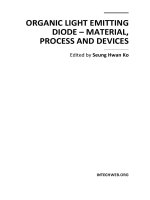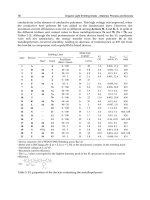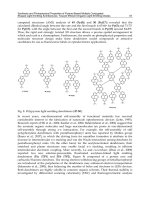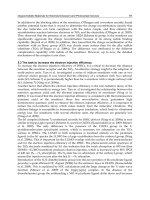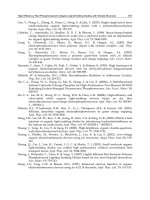Organic Light Emitting Diode Material Process and Devices Part 14 pot
Bạn đang xem bản rút gọn của tài liệu. Xem và tải ngay bản đầy đủ của tài liệu tại đây (345.8 KB, 7 trang )
Organic Light Emitting Diode – Material, Process and Devices
316
4.3 Results of fluorescent OLED
First we show the characteristics of the fluorescent device without applying the magnetic field.
Figure 4(a) shows the emission intensity and current of the fluorescent OLED as a function of
voltage, together with those of a phosphorescent device (Fig.4(b)). It is reported that TTA in
Alq-based fluorescent OLEDs occurs when the current density is larger than 100 mA/cm
2
(Kondakov 2007) and some of our measurement exceeds this limit. However, since the
magnetic field dependence of TTA appears only at low temperatures (Lei et al. 2009, Liu et al.
2009), we consider we can neglect contribution from TTA in the present measurement at 300 K.
Fig. 4. I-V and light emitting properties of (a) fluorescent and (b) phosphorescent devices
without magnetic field.
The emission intensity, current and emission efficiency of the same device under the
magnetic field are shown in Fig. 5. The emission intensity and current show different
magnetic field dependence on the sweep direction (0 -> 9T / 9 -> 0T) (Fig 5 (a)(b)). However,
their ratio, i.e. emission efficiency, does not show the hysteresis as shown in Fig. 5(c). It
means that the hysteresis comes from the charge injection process from the electrodes to the
emission layer. We found that the "hysteresis" is dependent on both of the magnetic field
and the time from the start of the current flow. The time dependence is probably due to the
bias stress on the device, but the magnetic field dependence might be related with MFE of
the trap / detrap processes.
Fig. 5. Magnetic field effect of the fluorescent device (normalized at zero field). ((a) Emission
Intensity, (b) Current, (c) Emission Efficiency at 4V). The arrows show the sweep direction.
The emission efficiency (and also the emission intensity and the current) increase steeply as
a function of B when it was less than 0.02 T as reported in the literature, and gradually
Effect of High Magnetic Field on Organic Light Emitting Diodes
317
decreases as B was further increased. It should be noted that the decrease in the mid~ high B
region is convex function, which cannot be explained by widely accepted behavior of hfc,
g
and TTA mechanisms which exhibit concave behavior against B. We will discuss this point
later.
In order to see dependence on B more clearly, we re-plotted Fig. 5(c) as a function of B
2
.
Figure 6(a) clearly shows the linear decrease of the fluorescent efficiency against B
2
in the
range of 0.1 T~ 6.5 T. On the other hand, by re-plotting Fig 5(c) as a function of B
1/2
(Fig.
6(b)), it is noticed that the decrease of the emission efficiency shows B
1/2
dependence in the
range of 6.5 T ~ 9 T.
Fig. 6. Normalized emission efficiency of the fluorescent device plotted as a function of (a)
B
2
(b) B
1/2
.
4.4 Results on phosphorescent OLED
Figure 7 shows the MFE on the emission efficiency of the phosphorescent OLED. In contrast
to the results of the fluorescent device, it did not show the magnetic field dependence.
Although we changed the driving voltage (4V, 6V, 8V, 10V), the magnetic field dependence
did not appear.
Fig. 7. Magnetic field effect of the phosphorescent device (normalized at zero field). The
result at 10V is shown.
Organic Light Emitting Diode – Material, Process and Devices
318
4.5 Magnetoconductance measurement of unipolar devices
In order to investigate the charge balance factor which might influence the EL efficiency, we
measured the magnetoresistance of the majority and minority carriers in -NPD and Alq by
making the unijunction devices with different work function electrodes (Au and Cs). All of
the devices showed Ohmic I -V characteristics in the measured range (-10~10V). The results
of MFE on the current at constant voltage are shown in Figs. 8(a)-(d). The voltages were
chosen to give current in the range of 10~100 A and the results are shown after
normalization at zero field. It is easily noticed that the MFEs on the conductivity of the
majority carriers (holes in -NPD and electrons in Alq) are negligible, whereas linear
decreases in the conductivity was observed for the minority carriers (electrons in -NPD
and holes in Alq). Since the I-V characteristics are Ohmic, it shows the carrier mobility
values of the minority carriers decrease linearly as a function of the magnetic field.
Fig. 8. Magnetic field effect of conductance of unipolar devices (normalized at zero field).
(a)Au/-NPD/Au (holes) (b)Au/Cs/-NPD/Cs/Au (electrons) (c)Au/Cs/Alq/Cs/Au
(electrons) (d)Au/Alq/Au (holes)
Also it should be noted that steep increase around zero field was not observed in unipolar
devices, which agrees with previous reports (Yusoff, 2009).
4.6 Discussions – the origin of field dependence
We found the decrease in the fluorescent efficiency in organic EL devices proportional to B
2
in the range of 0.1~6.5T. Such dependence has not been reported to the authors' knowledge.
The EL efficiency (
ext
) is given by the following:
ext
=
PL
exciton
(2)
Here,
,
PL
,
exciton
,
are the light extraction efficiency, quantum efficiency of organic
material, exciton formation efficiency, and carrier balance factor, respectively.
is related with the magnetic field via Faraday /Kerr effects with interference. The Faraday
rotation of the non-magnetic and thin organic layers is not significant even at 9T and
interference would not change as a function of magnetic field. Thus we can neglect
. The
fluorescent in optically excited organic dyes in the magnetic field has been studied in detail
(Katoh & Kotani 1992), but B
2
dependence in high magnetic field was not reported in the
literature. Therefore, our result cannot be explained by
PL
. Since all known mechanism of
Effect of High Magnetic Field on Organic Light Emitting Diodes
319
MFE on
exciton
gives concave dependence on B as mentioned earlier, we here tentatively
rule out the contribution from
exciton
as the main mechanism of the present B
2
dependence.
The remaining factor in eq. (2) is the charge balance factor. We examined various models to
relate the MFE on the charge balance factor, and the following is the only model that can
barely explain the B
2
dependence. We observed that the conductance of the minority carrier
changes linearly as a function of magnetic field as shown in Fig. 8. We considered various
models based on our observation that the mobility of the minority carrier (
) depends upon
the magnetic field (B) as
=
0
(1 - aB) (3)
where
0
and a are materials dependent constants. Since the EL intensity is determined
only by the charge balance if the carrier recombination rate is proportional to the
radiation (Scott et al. 1997), eq. (3) gives the fluorescent efficiency linearly related with B
1
.
However, our experiments showed that the current remains almost constant as a function
of the magnetic field in the mid ~ high B range. We have found that we can deduce the B
2
dependence from eq. (3) with additional two assumptions. The assumptions are as
follows. (i) The emission region is very narrow and only the recombination at this region
contributes to the emission. This is reasonable because Alq layer (200nm) is much thicker
than the thickness of emission region of ordinary devices. The interfacial mixing and the
damage caused by the electrode formation might also justify this assumption. (ii) The hole
current (J
h
) and electron current (J
e
) are balanced in the emission region when B = 0. Since
the mobility of the majority carrier is smaller in Alq than -NPD (Kepler et al. 1995,
Nguyen et al. 2007), it is believed that the recombination and the emission occurs in Alq.
This assumption is also reasonable because the device characteristics (Fig. 4), in which
turn-on voltage of current is almost the same as that of emission intensity, show that this
device has good carrier balance.
Since the current is constant as a function of B, J
h
+ J
e
is constant. From the assumption (ii), J
h
= J
e
at the emission region when B=0. The emission region is in Alq and Eq.(3) becomes
J
h
= J
0
(1-aB), (4)
where J
0
is a constant.
Because J
h
+J
e
is constant, J
e
at the emission region can be written as
J
e
=J
0
(1+aB). (5)
The recombination rate is proportional to J
h
J
e
J
h
J
e
= J
0
2
(1-aB)(1+aB) = J
0
2
(1-a
2
B
2
) (6)
and the decrease of the emission proportional to B
2
is explained.
We understand that the carrier transport of unipolar devices are not the same as the bipolar
devices, for example, charge injection at the electrodes might be strongly involved in the
minority carriers. However, our finding of linear MFE on minority carriers has not been
reported and no theoretical prediction has been made to the author's knowledge. There
might exist other mechanisms which also explain these results, but we hope the present
result and discussions may stimulate the study of MFE on organic semiconductors and
devices. Although TTA is not likely to work at room temperature and hfc will saturate at
Organic Light Emitting Diode – Material, Process and Devices
320
relatively low magnetic field,
G works at high magnetic field region and might be
cooperative with other factors.
There is another mechanism which might explain the B
2
dependence, although it is not
consistent with the results on the unipolar devices (eq.(3)). It is theoretically predicted that the
decrease of the conductivity proportional to B
2
is characteristics of magnetoresistance of
hopping transport and that it levels off to the B
1
dependence when the magnetic field is high
(Kepler et al. 1995). If it is applicable to the carriers in the emission layer of an OLED, the
charge balance of the device will change in the same manner as the conductance and the
emission decrease proportional to B
2
will be observed. The difficulty of this model is that we
did not see such magnetoconductance in unipolar devices with organic single layers.
In the range beyond 6.5T, we observed B
1/2
dependence (Fig. 6(b)). In the study of the
radical pair in solution, it is known that the density of singlet excitons decreases in
proportion to B
1/2
by
g mechanism (Sakaguchi & Hayashi 1995). The magnetoconductance
of the minority carriers shown in Fig. 8 start to saturate in the range beyond 6.5 T. It might
be the reason why B
1/2
dependence due to
g mechanism start to appear in this region.
We did not find observable MFE in phosphorescent OLEDs (Fig.7). This result indicates that
intersystem crossing occurs so fast in RPs and excited state molecules that Larmor precession
in
g mechanism does not affect the recombination kinetics. It also suggest that the charge
balance effect discussed above does not come into play. It will be interesting to measure the
magnetoconductance of organic semiconductors doped with phosphorescent dyes.
5. Conclusion
We reviewed recent studies on organic spintronics and MFE on chemical reactions in
relation to the MFE on OLEDs. We measured EL efficiency of fluorescent and
phosphorescent OLEDs in the magnetic field up to 9T and in the fluorescent device we
found quadratic decrease as a function of the magnetic field between 0.1 ~ 6.5T. We also
measured magnetoconductance of unipolar devices and observed that only minority carriers
show significant magnetoconductance decreasing linearly with the magnetic field (15% at 9T
in Alq). B
1/2
dependence in the range beyond 6.5T can be explained by MFE on the density
of singlet exciton caused by
g mechanism. In contrast, we did not find any MFE in the
phosphorescent devices.
6. Acknowledgment
The author is grateful to the collaboration and discussions with Mr. Yuichiro Goto, Mr.
Takuya Noguchi, Mr. Utahito Takeuchi, Dr. Kunitada Hatabayashi, Dr. Yasushi Hirose,
Prof. Takehiko Sasaki, Prof. Tetsuya Hasegawa
(all at the University of Tokyo). He would
like to thank Prof. Takayuki Uchida (Tokyo Polytechnic University) for valuable information
on the fabrication of OLED.
7. References
Baldo, MA, Lamansky, S., Burrows, PE, Thompson, ME & Forrest, SR (1999) Very high-
efficiency green organic light-emitting devices based on electrophosphorescence,
Appl Phys Lett 1999, 75, 4-6.
Effect of High Magnetic Field on Organic Light Emitting Diodes
321
Bobbert, P.A.; Nguyen, T.D., van Oost, F.W.A., Koopmans, B. & Wohlgenannt, M. (2007)
Bipolaron Mechanism for Organic Magnetoresistance, Phys. Rev. Lett. 99 (2007)
216801/1-216801/4.
Davis, A.H. & Bussmann, K. (2004) Large magnetic field effects in organic light emitting
diodes based on tris(8-hydroxyquinoline aluminum) (Alq3)/N,N′-Di (naphthalen-
1-yl)-N,N′diphenyl-benzidine (NPB) bilayers , J. Vac. Sci. Technol. A 22 (2004) 1885-
1891.
Dediu, V., Murgia, M., Matacotta, F.C., Taliani, C., Barbanera, S. (2002) Room temperature
spin polarized injection in organic semiconductor, Solid State Commun., 123, 181-
184(2002)
Desai, P.; Shakya, P., Kreouzi, T. & Gillin, W.P. (2007) , The role of magnetic fields on the
transport and efficiency of aluminum tris(8-hydroxyquinoline) based organic light
emitting diodes, J. Appl. Phys. 102 (2007) 073710/1-073710//5.
Desai, P.; Shakya, P., Kreouzis, T. & Gillin, W.P. (2007) Magnetoresistance and efficiency
measurements of Alq3-based OLEDs, Phys. Rev. B 75 (2007) 094423/1-094423/5.
Goto, Y., Noguchi, T., Takeuchi, U., Hatabayashi, K., Hirose, Y., Uchida, T., Sasaki, T.,
Hasegawa, T., Shimada, T., (2010), High magnetic field effect in organic light
emitting diodes, Org. Elec. 11 (2010) 1212-1216.
Hayashi, H.& Sakaguchi, Y. (2005) Magnetic field effects and CIDEP due to the d-type
triplet mechanism in intra-molecular reactions , J. Photochem. Photobiol. C :
Photochem. Reviews, 6 (2005) 25-36.
Hu, B. & Wu, Y. (2007) Tuning magnetoresistance between positive and negative values in
organic semiconductors, Nature Mat. 6 (2007) 985-991.
Kalinouski, J; (1997). in Organic Electroluminescent Materials and Devices, Gordon
Publishers (Eds. Miyata, S. & Nalwa, H.S.), New York, 1997. ISBN 2919875108
Kalinouski,J., Cocchi, J., Virgili, D., Marco, P.D. & Fattori, V. (2003). Magnetic field effects on
emission and current in Alq3-based electroluminescent diodes, Chem. Phys. Lett.
380 (2003) 710-715.
Kalinowski, J., Cocchi, M., Virgili, D., Fattori ,V.& Marco, P.D. (2004). Magnetic field effects
on organic electrophosphorescence, Phys. Rev. B 70 (2004) 205303.
Katoh, R. & Kotani, M. (1992) Fission of a higher excited state generated by singlet exciton
fusion in an anthracene crystal, Chem. Phys. Lett. 196 (1992) 108-112.
Kepler, R. G.; Beeson, P. M., Jacobs, S. J., Anderson, R. A., Sinclair, M. B., Valencia, V. S. &
Cahill, P. A. (1995), Electron and hole mobility in tris (8‐hydroxyquinolinolato
‐N1,O8) aluminum, Appl. Phys. Lett, 66 (1995) 3618-3620.
Kondakov, D.Y. (2007) Characterization of triplet-triplet annihilation in organic light-
emitting diodes based on anthracene derivatives, J. Appl. Phys. 102 (2007) 114504/1-
114504/5.
Lei, Y.L., Zhang, Y., Lui, R., Chen, P., Song, Q.L. & Xiong, Z.H. (2009), Driving current and
temperature dependent magnetic-field modulated electroluminescence in Alq3-
based organic light emitting diode, Organic Electronics 10 (2009) 889-894.
Liu, R., Zhang, Y., Lei, Y.L., Chen, P. & Xiong, Z.H. (2009) Magnetic field dependent triplet-
triplet annihilation in Alq3-based organic light emitting diodes at
different
temperatures, J. Appl. Phys. 105 (2009) 093719/1-093719/5.
Matsumoto, Y., Sakai, S. Takagi, Y., Nakagawa , T., Yokoyama, T. , Shimada, T., Mitani, S.,
Naramoto, H., Maeda, Y. , X-ray absorption spectroscopy and magnetic circular
Organic Light Emitting Diode – Material, Process and Devices
322
dichroism in codeposited C60–Co films with giant tunnel magnetoresistance, Chem.
Phys. Lett. 470 (2009) 244–248.
Miwa, S., Shiraishi, M., Tanabe, S., Mizuguchi, M., Shinjo, T., Suzuki, Y. (2007) Tunnel
magnetoresistance of C60-Co nanocomposites and spin-dependent transport in
organic semiconductors, Phys. Rev. B 76 (2007) 214414/1-214414/7.
Nguyen, N. D.; Schmeits, M. & Loebl, H. P. (2007) Determination of charge-carrier
transport in organic devices by admittance spectroscopy: Application to hole
mobility in α-NPD, Phys. Rev. B 75 (2007) 075307/1-075307/13.
Odaka, H.; Okimoto Y., Yamada, T., Okamoto, H., Kawasaki, M. & Tokura, Y. (2006).
Control of magnetic-field effect on electroluminescence in Alq3-based organic light
emitting diodes, Appl. Phys. Lett, 88 (2006) 123501/1-123501/3.
Reufer, M.; Walter, M.J., Lagoudakis, P.G., Hummel, A.B., Kolb, H.S., Roskos, H.G., Scherf,
U. & Lupton, J.M. (2005) Spin-conserving carrier recombination in conjugated
polymers, Nature Mat. 4 (2005) 340-346.
Sakaguchi, Y.; Iwasaki, Y., Osasa T., Asahi, M. & Matsumura M. (2006). Fractions of singlet
and triplet excitons generated in organic light-emitting devices based on a
polyphenylenevinylene derivative, Phys. Rev. B 74 (2006) 195209/1-195209/8.
Sakaguchi, Y. & Hayashi, H. (1995), Magnetic field effects on the photodissociation reaction
of triphenylphosphine in non-viscous homogeneous solutions , Chem. Phys. Lett.
245 (1995) 591-597.
Sakai,S., Yakushiji, K., Mitani, S., Takanashi, K. Naramoto, H. Avramov, P.V., Narumi K.,
Lavrentiev, V., Maeda, Y. (2006)., Tunnel magnetoresistance in Co
nanoparticle/Co–C60 compound hybrid system Appl. Phys. Lett. 89 (2006)
113118/1-113118/3.
Scott, J.C.; Karg, S. & Carter, S.A. (1997) Bipolar charge and current distributions in organic
light-emitting diodes, J. Appl. Phys. 82 (1997) 1454-1460.
Shakya, P.; Desai, P., Somerton, M., Gannaway, G., Kreouzis, T. & Gillin, W.P. (2008) , The
magnetic field effect on the transport and efficiency of group III tris(8-
hydroxyquinoline) organic light emitting diodes, J. Appl. Phys. 103 (2008)
103175/1-103175/5.
Shemg, Y.; Nguyen, T.D., Veeraraghavan, G.& Mermer, O. (2007) Effect of spin-orbit
coupling on magnetoresistance in organic semiconductors, Phys. Rev. B 75 (2007)
035202/1-035202/7.
Sun, C.J., Wu, Y., Xu, Z., Hu, B., Bai, J. Wang, J. P. & Shen, J. (2007) Enhancement of
quantum efficiency of organic light emitting devices by doping magnetic
nanoparticles , Appl. Phys. Lett. 90 (2007) 232110/1-232110/3.
Yusoff, A.R.B.M., da Silva, W.J., Serbena, J P. M. , Meruvia, M. S. & Hümmelgen, I.A. (2009)
Very High Magnetocurrent in Tris-(8-hydroxyquinoline) Aluminum-Based Bipolar
Charge Injection Devices – Appl. Phys. Lett. 94 (2009) 253305/1-253305/3.
Zhan, Y., Holmström, E., Lizárraga, R., Eriksson, O., Liu, X., Li, F., Carlegrim, E., Stafström,
S. & Fahlman, M., (2010),Efficient Spin Injection Through Exchange Coupling at
Organic Semiconductor/Ferromagnet Heterojunctions, Adv. Mater., 22 (2010) 1626.



